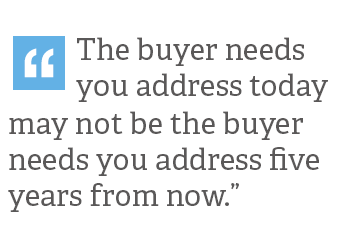What If Your Biggest Competitor in 2019 Does Not Exist Today?
Disruptive innovation is a term coined by Clayton Christensen, a Harvard professor and author of the famous 1997 book The Innovator’s Dilemma. His disruptive innovation theory describes a process by which an offering takes root at the bottom of the market and then relentlessly moves up-market, eventually displacing established competitors.

At SiriusDecisions, we have an adjusted B2B perspective on this theory. Market disruption occurs any time the buyer need is reframed or a new buyer need is discovered. Technology is an enabler of the change in the buyer need which is ultimately the source of disruption (not the technology in and of itself).
The classic current case study of a disrupter in a market segment is ridesharing app Uber. Five years ago, Uber started in a niche market in San Francisco and is now global in 200 cities, completely transforming how the taxi transportation ecosystem works. Interestingly enough, the change did not come about simply from the technological innovation of Uber’s app. Instead, Uber re-invented the buyer need, changing it from “being driven” to “seamlessly connecting riders and drivers directly.” The moral of the Uber story: The buyer needs you address today may not be the buyer needs you address five years from now.
So, how do you think differently about the competition? Typically, we see clients use tried-and-true SWOT analyst frameworks or other product-myopic assessments to analyze the competition. The problem with those frameworks is that they are too focused on a product-to-product comparison, or they are too high-level, evaluating a company in isolation from market segment dynamics.
SiriusDecisions recommends that clients analyze competitors in a specific market segment against two major dimensions:
- The ability to disrupt. Organizations that score high in their ability to disrupt demonstrate characteristics such as innovation, a willingness to take risks, access to funds and an ability to respond to market triggers.
- The ability to go to market. Organizations that score high in their ability to go to market demonstrate qualities such as deep understanding of their buyer audience, strong sales and marketing leadership, and positive early-adopter brand perception and loyalty.
Disruptive ability is not enough – organizations must be able to market and sell their offerings in order to pose a competitive threat. Monitor emerging competitors, even if they are not yet a cause for concern, because you never know when that “ankle biter” will become a lethal threat to your company. For SiriusDecisions clients, the brief Introducing the SiriusDecisions Competitive Analysis Model provides more information.
** Registration for the SiriusDecisions 2015 Summit, to be held May 12 – 15, 2015 in Nashville, TN, is now open! This year’s conference, themed Outperform: Strategies for Intelligent Growth, will focus on effective ways to grow and outperform in today’s competitive marketplace. Register today!